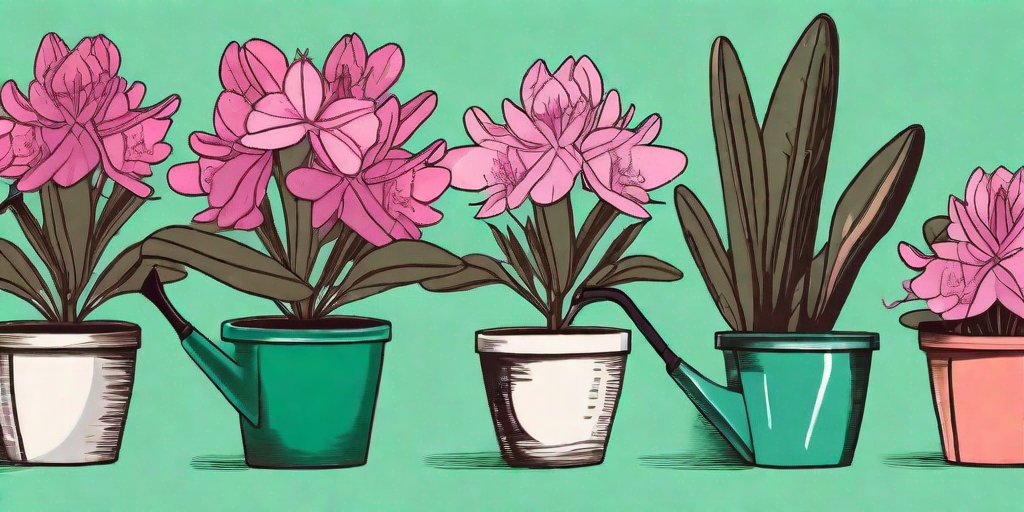
Rhododendrons are the divas of the garden, with their flamboyant blooms and lush foliage. However, they can be a bit fussy, especially when it comes to their living arrangements. But don't worry, with a little bit of know-how and a dash of cheeky humor, we'll have your rhododendrons strutting their stuff in no time.
Choosing the Right Rhododendron
Not all rhododendrons are created equal. Some are divas, some are wallflowers, and some are just plain weird. But they all have their own unique charm. So, how do you choose the right one for your garden?
First, consider the size. Rhododendrons can range from petite shrubs to towering trees. If you're growing them in pots, you'll want to stick with the smaller varieties. Dwarf rhododendrons are ideal, as they typically grow no more than 3 feet tall.
Next, consider the color. Rhododendrons come in a rainbow of hues, from pure white to deep purple. Choose a color that complements your garden and makes your heart sing.
Finally, consider the bloom time. Some rhododendrons bloom in early spring, while others wait until summer. By choosing varieties with different bloom times, you can enjoy a continuous display of flowers.
Our Top Rhododendron Picks
- 'PJM Elite': This compact variety is a real showstopper, with vibrant pink flowers and glossy, evergreen leaves.
- 'Dora Amateis': A petite beauty with pure white flowers and a sweet fragrance.
- 'Blue Baron': This unique variety boasts stunning blue-purple flowers. It's a bit of a diva, but worth the extra effort.
Preparing the Pot
Once you've chosen your rhododendron, it's time to prepare its new home. Rhododendrons are a bit like Goldilocks - they like their soil just right. Not too wet, not too dry, but just right.
Start with a pot that's at least twice the size of the root ball. This gives the roots plenty of room to spread out and get comfortable. Make sure the pot has good drainage, as rhododendrons hate wet feet.
Fill the pot with a mix of ericaceous compost and perlite. This provides the acidic conditions that rhododendrons love, while also improving drainage.
Finally, plant the rhododendron at the same depth it was growing in its nursery pot. This ensures that the roots are at the right level for optimal growth.
Caring for Your Rhododendron
Now that your rhododendron is all settled in, it's time to take care of it. This involves watering, feeding, pruning, and protecting it from pests and diseases.
Water your rhododendron regularly, but be careful not to overwater. The soil should be moist, but not soggy. If the leaves start to yellow, you're probably overdoing it.
Feed your rhododendron with a slow-release fertilizer designed for acid-loving plants. This provides the nutrients it needs to produce those fabulous flowers.
Prune your rhododendron after it finishes blooming to maintain its shape and encourage more flowers next year. Just be careful not to cut into the old wood, as this can harm the plant.
Keep an eye out for pests and diseases. Rhododendrons are generally healthy plants, but they can be affected by aphids, root rot, and leaf spot. If you notice any problems, treat them promptly to prevent them from spreading.
FAQs
Why are my rhododendron's leaves turning yellow?
This could be a sign of overwatering. Try cutting back on the water and see if the leaves improve. If not, it could be a sign of a nutrient deficiency. Try feeding your rhododendron with a slow-release fertilizer designed for acid-loving plants.
Why aren't my rhododendrons blooming?
There could be several reasons for this. It could be that the plant is not getting enough light, or that it's not getting the right nutrients. Try moving the pot to a sunnier spot and feeding it with a slow-release fertilizer designed for acid-loving plants.
Can I grow rhododendrons from seed?
Yes, you can, but it's not for the faint of heart. Rhododendrons are slow growers, and it can take several years for a seedling to bloom. If you're up for the challenge, go for it!
Conclusion
So there you have it - the ins and outs of growing rhododendrons in pots. With a bit of care and attention, you can enjoy these stunning plants in your own garden. So why not give it a try? After all, every garden needs a diva.















